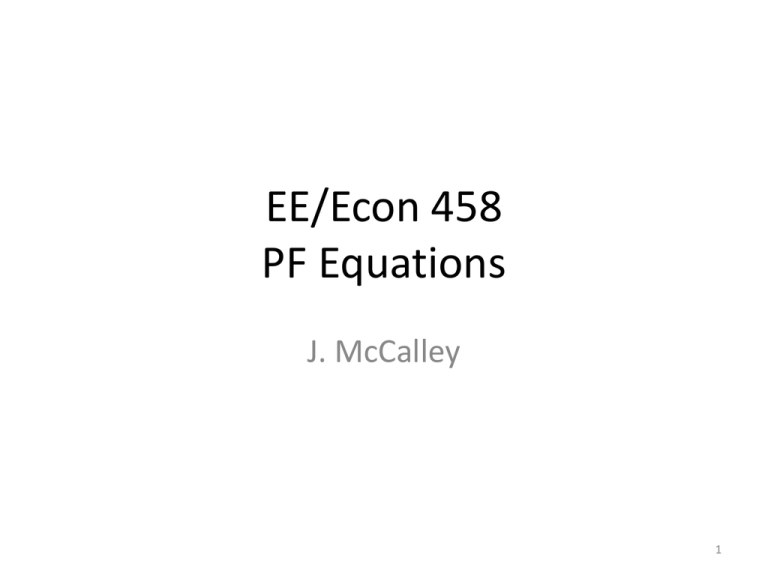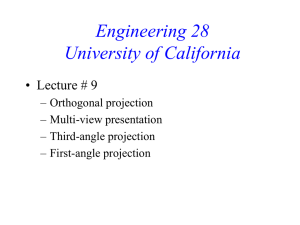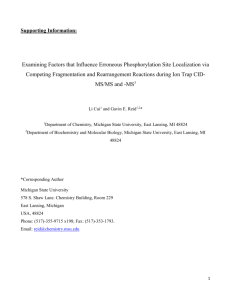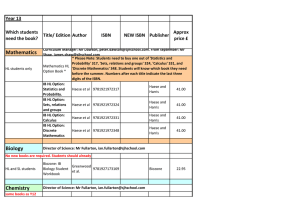Power system representation NETWORK
advertisement

EE/Econ 458 PF Equations J. McCalley 1 Power system representation NODE or BUS (substation) BRANCHES (lines or transformers) NETWORK (but unloaded and unsupplied) 2 Power system representation LOAD: Extracts MW out of the node (injects negative MW into the node) GENERATOR: Injects MW into the node NETWORK (loaded and supplied) 3 Power system representation Approximate branch model Best branch model NETWORK (loaded and supplied) 4 Power system representation Approximate branch model Branch resistance Branch inductive reactance Branch capacitive susceptance Ignore resistance, OK because it is much less than reactance. Ignore susceptance, OK because its affect on MW flows very small. Only model reactance, OK for getting branch flows. 5 Power system representation Here is what we will model as a network (reactance only) NETWORK (loaded and supplied) 6 Power system representation The impedance is a complex number zij=rij+jxij. We ignore the resistance: zij=jxij z12 2 1 z13 z14 4 z23 z34 3 7 Power system representation Impedance relates voltage drop and current via Ohm’s law: I ij Current(amps) z ij (V i V j ) Voltage drop (volts) Vi i 1 Iij Vj zij j 8 Power system representation I ij 1 z ij (V i V j ) Admittance, yij, is the inverse of impedance, zij: I ij y ij (V i V j ) Vi i Iij Vj yij j 9 Power system representation Label the admittances yij y12 2 1 y13 y14 4 y23 y34 3 10 Power system representation Current injections: Ii flowing into bus i from generator or load. Positive if generator; negative if load. I1, I4 will be positive. I3 will be negative. I2 will be positive if gen exceeds load, I1 y12 I2 otherwise negative. 2 1 y13 y14 4 y23 y34 I4 3 I3 11 Power system representation Voltages: Vi is voltage at bus i. I1 y12 I2 2 1 V2 V1 y13 y14 y23 V4 4 y34 I4 3 I3 V3 12 Power system representation Kirchoff’s current law: sum of the currents at any node must be zero. I 1 I 12 I 13 I 14 I1 y12 1 2 I12 V1 I14 y14 I2 V2 y13 I13 y23 V4 4 y34 I4 3 Note: We assume there are no bus shunts in this system. Bus shunts are capacitive or inductive connections between the bus and the ground. Although most systems have them, they inject only reactive power (no MW) and therefore affect MW flows in the network only very little. V3 I3 13 Power system representation Now express each current using Ohm’s law: I ij y ij (V i V j ) I 1 I 12 I 13 I 14 I 1 y12 (V1 V 2 ) y13 (V1 V 3 ) y14 (V1 V 4 ) I1 y12 1 2 I12 V1 I14 y14 I2 V2 y13 I13 y23 V4 4 y34 I4 3 I3 V3 14 Power system representation Now collect like terms in the voltages: I 1 y12 (V1 V 2 ) y13 (V1 V 3 ) y14 (V1 V 4 ) I 1 V1 ( y12 y13 y14 ) V 2 ( y12 ) V 3 ( y13 ) V 4 ( y14 ) I1 y12 1 2 I12 V1 I14 y14 I2 V2 y13 I13 y23 V4 4 y34 I4 3 I3 V3 15 Power system representation Repeat for the other four buses: I 1 V1 ( y12 y13 y14 ) V 2 ( y12 ) V 3 ( y13 ) V 4 ( y14 ) I 2 V1 ( y 21 ) V 2 ( y 21 y 23 y 24 ) V 3 ( y 23 ) V 4 ( y 24 ) I 3 V1 ( y 31 ) V 2 ( y 32 ) V 3 ( y 31 y 32 y 34 ) V 4 ( y 34 ) I 4 V1 ( y 41 ) V 2 ( y 42 ) V 3 ( y 41 y 42 y 43 ) V 4 ( y 43 ) I1 y12 1 2 I12 V1 I14 y14 I2 V2 y13 I13 y23 V4 4 y34 I4 3 I3 V3 16 Power system representation Repeat for the other four buses: I 1 V1 ( y12 y13 y14 ) V 2 ( y12 ) V 3 ( y13 ) V 4 ( y14 ) I 2 V1 ( y 21 ) V 2 ( y 21 y 23 y 24 ) V 3 ( y 23 ) V 4 ( y 24 ) I 3 V1 ( y 31 ) V 2 ( y 32 ) V 3 ( y 31 y 32 y 34 ) V 4 ( y 34 ) I 4 V1 ( y 41 ) V 2 ( y 42 ) V 3 ( y 41 y 42 y 43 ) V 4 ( y 43 ) I1 y12 1 2 I12 V1 I14 y14 I2 V2 y13 I13 y23 V4 4 y34 I4 Notes: 1. yij=yji 2. If branch ij does not exist, then yij=0. 3 I3 V3 17 Power system representation Write in matrix form: I 1 y 12 I 2 I3 I4 y 13 y 14 y 12 y13 y 14 y 21 y 21 y 23 y 24 y 23 y 31 y 32 y 31 y 32 y 34 y 41 y 42 y 43 y 41 V1 y 24 V 2 V 3 y 34 y 42 y 43 V 4 Define the Y-bus: y 12 Y y 13 y 14 y 12 y 13 y 21 y 21 y 23 y 24 y 23 y 31 y 32 y 31 y 32 y 34 y 41 y 42 y 43 y 14 y 41 y 24 y 34 y 42 y 43 Define elements of the Y-bus: Y11 Y 21 Y Y 31 Y 41 Y12 Y13 Y 22 Y 23 Y 32 Y 33 Y 42 Y 43 Y14 Y 24 Y 34 Y 44 I 1 Y 11 Y I 2 21 I 3 Y 31 I 4 Y 41 Y 12 Y 13 Y 22 Y 23 Y 32 Y 33 Y 42 Y 43 Y 14 V 1 Y 24 V 2 Y 34 V 3 Y 44 V 4 18 Power system representation Forming the Y-Bus: 1. The matrix is symmetric, i.e., Yij=Yji. 2. A diagonal element Yii is obtained as the sum of admittances for all branches connected to bus i (yik is non-zero only when there exists a physical connection between buses i and k). 3. The off-diagonal elements are the negative of the admittances connecting buses i and j, i.e., Yij=-yji. 19 Power system representation From the previous work, you can derive the power flow equations. These are equations expressing the real and reactive power injections at each bus. If we had modeled branch resistance, we would obtain: N Pk V k V j G kj cos( k j ) B kj sin( k j ) j 1 N Qk V k V j G kj sin( k j ) B kj cos( k j ) j 1 where Yij=Gij+jBij. This requires too much EE, so forget about them. Let’s make some assumptions instead. But first, what is θk and θj? 20 Power system representation N Pk V k V j G kj cos( k j ) B kj sin( k j ) j 1 N Qk V k V j G kj sin( k j ) B kj cos( k j ) θk and θj are the angles of the voltage phasors at each bus. j 1 The angle captures the time difference when voltage phasors cross the zerovoltage axis. In the time domain simulation, the red curve crosses before the blue one by an amount of time Δt and so has an angle of θ=ωΔt where ω=2πf and f is frequency of oscillation, 60 Hz for power systems. 21 Power system representation Simplifying assumptions: 1. No resistance: Yij=jBij 2. Angle differences across branches, are small: θi-θj: • Sin(θi-θj)= θi-θj • Cos(θi-θj)=1.0 3. All voltage magnitudes are 1.0 in the pu system. N Pk B kj ( k j ) j 1 , jk This is the basis for the “DC power flow.” Per-unit system: A system where all quantities are normalized to a consistent set of bases. It will result in powers being expressed as a particular number of “100 MVA” quantities. Admittance is also perunitized. 22 Example Pg2=2pu Pg1=2pu 1 2 y12 =-j10 y14 =-j10 y13 =-j10 Pd2=1pu y23 =-j10 N y34 =-j10 4 Pg4=1pu 3 Pd3=4pu Pk B kj ( k j ) j 1 , jk P1 B12 ( 1 2 ) B13 ( 1 3 ) B14 ( 1 4 ) B12 1 B12 2 B13 1 B13 3 B14 1 B14 4 Collect terms in the same variables P1 B12 B13 B14 1 B12 2 B13 3 B14 4 Repeat procedure for buses 2, 3, 4: P2 B 21 1 B 21 B 23 B 24 2 B 23 3 B 24 4 P3 B 31 1 B 32 2 B 31 B 32 B 34 3 B 34 4 P4 B 41 1 B 42 2 B 43 3 B 41 B 42 B 43 4 23 Example Pg2=2pu Pg1=2pu 1 2 y12 =-j10 y14 =-j10 y13 =-j10 Pd2=1pu N y34 =-j10 4 y23 =-j10 3 Pg4=1pu Pk B kj ( k j ) j 1 , jk Pd3=4pu Now write in matrix form: P1 B12 P 2 P3 P4 B13 B14 B12 B13 B 21 B 21 B 23 B 24 B 23 B 31 B 32 B 31 B 32 B 34 B 41 B 42 B 43 1 B 24 2 3 B 34 B 42 B 43 4 B14 B 41 24 Example Compare: P1 B12 P 2 P3 P4 B11 B 21 Y j B 31 B 41 30 10 Y j 10 10 B13 B14 B12 B13 B 21 B 21 B 23 B 24 B 23 B 31 B 32 B 31 B 32 B 34 B 41 B 42 B 43 B12 B13 B 22 B 23 B 32 B 33 B 42 B 43 10 10 20 10 10 30 0 10 B14 B 24 B 34 B 44 b12 j 10 0 10 20 b13 b14 B 41 b12 b13 b 21 b 21 b 23 b 24 b 23 b 31 b 32 b 31 b 32 b 34 b 41 b 42 b 43 2 30 1 10 4 10 1 10 10 10 20 10 10 30 0 10 1 B 24 2 3 B 34 B 42 B 43 4 B14 b14 b 41 b 24 b34 b 42 b 43 10 1 0 2 10 3 20 4 25 2 30 1 10 4 10 1 10 10 10 20 10 10 30 0 10 Example 10 1 0 2 10 3 20 4 1 30 10 2 3 10 4 10 10 10 20 10 10 30 0 10 10 0 10 20 1 2 1 4 1 But matlab indicates above matrix is singular which means it does not have an inverse. There is a dependency among the four equations, i.e., we can add the bottom three rows and multiply by -1 to get the top row. This dependency occurs because all four angles are not independent; we have to choose one of them as a reference with a 26 fixed value of 0 degrees. Example Eliminate one of the equations and one of the variables by setting the variable to zero. We choose to eliminate the first equation and set the first variable θ1=0 degrees. 1 30 10 2 3 10 4 10 10 10 20 10 10 30 0 10 10 0 10 20 1 2 1 4 1 2 20 10 3 4 0 10 30 10 0 10 20 1 1 0 . 025 4 0 . 15 1 0 . 025 But we want power flows: Pkj B kj ( k j ) P12 B12 ( 1 2 ) 10 ( 0 0 . 025 ) 0 . 25 P13 B13 ( 1 3 ) 10 ( 0 0 . 15 ) 1 . 5 P14 B14 ( 1 4 ) 10 ( 0 0 . 025 ) 0 . 25 P23 B 23 ( 2 3 ) 10 ( 0 . 025 0 . 15 ) 1 . 25 P34 B 34 ( 3 4 ) 10 ( 0 . 15 0 . 025 ) 1 . 25 27 Example Resulting solution: Pg2=2pu Pg1=2pu 1 P14 =0.25 2 P12=0.25 P13=1.5 Pd2=1pu P43 =1.25 4 Pg4=1pu P23 =1.25 3 Pd3=4pu 28 Example Resulting solution: Pg2=2pu Pg1=2pu 1 P14 =0.25 2 P12=0.25 P13=1.5 Pd2=1pu P43 =1.25 4 Pg4=1pu P23 =1.25 3 Pd3=4pu 29 How to solve power flow problems Develop B’ matrix: P1 B12 P 2 P3 P4 B13 B14 B11 B 21 Y j B 31 B 41 B12 B13 B 22 B 23 B 32 B 33 B 42 B 43 1. 2. 3. 4. B12 B13 B 21 B 21 B 23 B 24 B 23 B 31 B 32 B 31 B 32 B 34 B 41 B 42 B 43 B14 B 24 B 34 B 44 b12 j Get the Y-bus Remove the “j” from the Y-bus. Multiply Y-bus by -1. Remove row 1 and column 1. 1 B 24 2 3 B 34 B 42 B 43 4 B14 B 41 b13 b14 b12 b13 b 21 b 21 b 23 b 24 b 23 b 31 b 32 b 31 b 32 b 34 b 41 b 42 b 43 30 10 Y j 10 10 10 10 20 10 10 30 0 10 b14 b 41 b 24 b34 b 42 b 43 10 0 10 20 20 B ' 10 0 10 30 10 0 10 20 30 How to solve power flow problems Develop equations to compute branch flows: P B ( D A) where: • PB is the vector of branch flows. It has dimension of M x 1. Branches are ordered arbitrarily, but whatever order is chosen must also be used in D and A. • θ is (as before) the vector of nodal phase angles for buses 2,…N • D is an M x M matrix having non-diagonal elements of zeros; the diagonal element in position row k, column k contains the negative of the susceptance of the kth branch. • A is the M x N-1 node-arc incidence matrix. It is also called the adjacency matrix, or the connection matrix. Its development requires a few comments. 31 How to solve power flow problems How to develop node-arc incidence matrix: • • • • • P B ( D A) number of rows equal to the number of branches (arcs) and a number of columns equal to the number of nodes. Element (k,j) of A is 1 if the kth branch begins at node j, -1 if the kth branch terminates at node j, and 0 otherwise. A branch is said to “begin” at node j if the power flowing across branch k is defined positive for a direction from node j to the other node. A branch is said to “terminate” at node j if the power flowing across branch k is defined positive for a direction to node j from the other node. Note that matrix A is of dimension M x N-1, i.e., it has only N-1 columns. This is because we do not form a column with the reference bus, in order to conform to the vector θ, which is of dimension (N-1) x 32 1. This works because the angle being excluded, θ1, is zero. How to solve power flow problems Pg2=2pu Pg1=2pu 1 2 2 1 5 Pd2=1pu 3 4 4 3 Pg4=1pu Pd3=4pu P B ( D A) 10 0 0 0 0 number node 2 3 4 0 0 0 10 0 0 0 10 0 0 0 10 0 0 0 0 0 0 -1 0 1 0 0 10 0 0 0 -1 -1 -1 - 1 0 0 1 0 0 -1 A 1 0 0 10 0 D 0 0 0 0 0 -1 -1 -1 - 1 0 0 1 0 0 0 0 10 0 0 0 10 0 0 0 10 0 0 0 1 2 3 branch 4 5 num ber 0 0 0 0 10 2 3 4 33 How to solve power flow problems PB 1 10 PB 2 0 PB 3 0 P B4 0 P 0 B5 0 0 0 10 0 0 0 10 0 0 0 10 0 0 0 0 4 10 4 2 10 2 0 0 2 3 10 ( 2 3 ) 0 3 4 10 ( 3 4 ) 10 3 10 3 Pg2=2pu Pg1=2pu 1 PB 1 0 . 25 PB 2 0 . 25 PB 3 1 . 25 P 1 . 25 B4 P 1 .5 B5 2 0 . 025 3 0 . 15 4 0 . 025 2 P12=0.25 P14 =0.25 P13=1.5 Pd2=1pu P43 =1.25 4 Pg4=1pu P23 =1.25 3 Pd3=4pu 34











